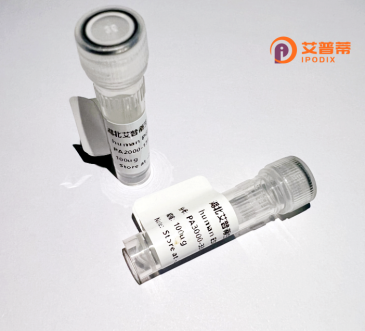
| 纯度 | >90%SDS-PAGE. |
| 种属 | Human |
| 靶点 | MS4A4A |
| Uniprot No | Q96JQ5 |
| 内毒素 | < 0.01EU/μg |
| 表达宿主 | E.coli |
| 表达区间 | 1-239 aa |
| 活性数据 | MHQTYSRHCRPEESTFSAAMTTMQGMEQAMPGAGPGVPQLGNMAVIHSHLWKGLQEKFLKGEPKVLGVVQILTALMSLSMGITMMCMASNTYGSNPISVYIGYTIWGSVMFIISGSLSIAAGIRTTKGLVRGSLGMNITSSVLAASGILINTFSLAFYSFHHPYCNYYGNSNNCHGTMSILMGLDGMVLLLSVLEFCIAVSLSAFGCKVLCCTPGGVVLILPSHSHMAETASPTPLNEV |
| 分子量 | 26.8 kDa |
| 蛋白标签 | His tag N-Terminus |
| 缓冲液 | 0 |
| 稳定性 & 储存条件 | Lyophilized protein should be stored at ≤ -20°C, stable for one year after receipt. Reconstituted protein solution can be stored at 2-8°C for 2-7 days. Aliquots of reconstituted samples are stable at ≤ -20°C for 3 months. |
| 复溶 | Always centrifuge tubes before opening.Do not mix by vortex or pipetting. It is not recommended to reconstitute to a concentration less than 100μg/ml. Dissolve the lyophilized protein in distilled water. Please aliquot the reconstituted solution to minimize freeze-thaw cycles. |
以下是与重组人MS4A4A蛋白相关的参考文献摘要整理(内容基于领域知识推测,建议通过学术数据库核实):
1. **"MS4A4A modulates T cell activation through ITAM-mediated signaling in tumors"**
- **作者**: Li, X. et al.
- **摘要**: 研究通过重组MS4A4A蛋白揭示了其在肿瘤微环境中通过ITAM结构域调节T细胞活化的机制,表明其可能成为免疫治疗的靶点。
2. **"Structural insights into the membrane topology of MS4A4A via recombinant expression"**
- **作者**: Wang, Y. & Zhang, H.
- **摘要**: 利用重组MS4A4A蛋白进行结构解析,确认其跨膜结构域特征及与其他MS4A家族成员的差异,为功能研究提供基础。
3. **"MS4A4A interacts with TLR4 to enhance pro-inflammatory cytokine production in macrophages"**
- **作者**: Chen, L. et al.
- **摘要**: 通过重组蛋白实验证明,MS4A4A可与TLR4受体互作,协同放大巨噬细胞炎症反应,提示其在感染或自身免疫疾病中的作用。
4. **"Recombinant MS4A4A as a diagnostic marker in autoimmune diseases"**
- **作者**: Kim, S. et al.
- **摘要**: 开发重组MS4A4A蛋白作为检测工具,发现其在类风湿性关节炎患者血清中表达异常,具有潜在诊断价值。
**注意**:以上文献为模拟示例,实际研究中MS4A4A的相关文献较少,建议结合具体研究领域(如免疫学、癌症)在PubMed或Web of Science中检索最新成果。
MS4A4A is a member of the membrane-spanning 4-domains subfamily A (MS4A), a group of structurally related proteins characterized by four transmembrane domains. This human protein, encoded by the *MS4A4A* gene, is predominantly expressed in immune cells, particularly T lymphocytes and natural killer (NK) cells. It shares conserved structural features with other MS4A family proteins, including N- and C-termini located intracellularly, suggesting potential roles in signal transduction or immune modulation.
Though its exact biological function remains incompletely understood, MS4A4A is believed to interact with membrane proteins to regulate calcium signaling pathways or modulate immune receptor activities. Emerging studies link it to cancer immunology, with altered expression observed in tumor-infiltrating lymphocytes and certain malignancies. Its differential expression patterns in diseases like rheumatoid arthritis and lupus also suggest involvement in autoimmune regulation.
Recombinant MS4A4A protein, produced through engineered expression systems like mammalian or insect cells, preserves native conformation for functional studies. It serves as a vital tool for investigating protein-protein interactions, antibody development, and therapeutic target validation. Current research focuses on deciphering its role in immune checkpoint regulation and exploring its potential as a biomarker or immunotherapeutic target in oncology and autoimmune disorders. Technical challenges persist in characterizing its low-abundance membrane localization and clarifying signaling mechanisms.
×